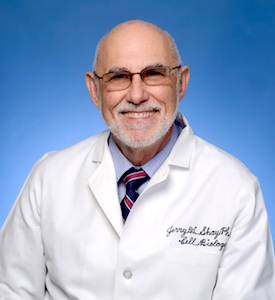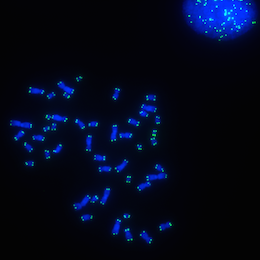Researchers discover genetic clue to why people develop disease as they age

DALLAS – December 15, 2016 – Researchers at UT Southwestern Medical Center have found a key to how the telomerase gene TERT influences the development of disease, opening up the possibility of treatment for some cancers and certain diseases that currently have no treatment options.
Telomeres are the endcaps of chromosomes. The lengths of the endcaps can influence cancer progression and aging.
“Our studies show that preventing telomeres from becoming too short may prevent or delay diseases such as pulmonary fibrosis, certain rare congenital disorders, and cancer,” said Dr. Jerry W. Shay, senior author of the study and Professor of Cell Biology “This study may help explain why most cancers occur in people age 65 and older.”
The study is published in PLOS Biology.
“We found in this research that when telomeres are long during development, the telomere loops over and helps to silence the telomerase gene that is only a small distance from the telomere. However, as we age and telomeres get progressively shorter, then telomerase becomes available for activation and possibly initiation of cancer,” said Dr. Shay, a member of the Harold C. Simmons Comprehensive Cancer Center, who holds The Southland Financial Corporation Distinguished Chair in Geriatrics. “Until this work, it was not known how telomerase was silenced in young cells.”
What is a telomere? Telomeres are the ends of chromosomes, which are gradually shortened with every cell division. Multiple studies have proposed that shortened telomeres correlate with human aging. Most cancers overcome the shortening of telomeres and aging by activating an enzyme called telomerase. This new model explains how telomere shortening with increased age may permit telomerase activation and cancer progression. |
Previously researchers thought aging was caused by a DNA damage signal from telomeres that have become too short. This work demonstrates that certain aspects of normal human aging can be regulated by progressively shortened telomeres not requiring a DNA damage signal, he said.
“This finding has value in understanding how we measure changes over decades. We believe that at various stages of human aging, different genes become activated or silenced via this mechanism,” said Dr. Shay.
The UT Southwestern research team has termed the findings in this study “telomere position effect over long distance,” or TPE-OLD. The researchers previously found a gene that is involved in a type of muscular dystrophy is also regulated by TPE.
The researchers caution that these studies were done in cells outside the body in cell culture, so extrapolation to humans is currently uncertain and will need additional study. The research is supported by the National Institutes of Health.
Additional UT Southwestern researchers in the Department of Cell Biology who contributed to the study include research assistants Dr. Wanil Kim (co-first author), Dr. Jaewon Min, Dr. Ilgen Mender, Dr. Tsung-Po Lai, and Dr. Ning Zhang; Dr. Andrew T. Ludlow, Assistant Instructor in Cell Biology and co-first author; and Dr. Woodring E. Wright, Professor of Cell Biology and Internal Medicine, who holds the Southland Financial Corporation Distinguished Chair in Geriatrics.
The Harold C. Simmons Comprehensive Cancer Center is the only NCI-designated Comprehensive Cancer Center in North Texas and one of just 47 NCI-designated Comprehensive Cancer Centers in the nation. Simmons Cancer Center includes 13 major cancer care programs. In addition, the Center’s education and training programs support and develop the next generation of cancer researchers and clinicians. Simmons Cancer Center is among only 30 U.S. cancer research centers to be designated by the NCI as a National Clinical Trials Network Lead Academic Participating Site.
About UT Southwestern Medical Center
UT Southwestern, one of the premier academic medical centers in the nation, integrates pioneering biomedical research with exceptional clinical care and education. The institution’s faculty includes many distinguished members, including six who have been awarded Nobel Prizes since 1985. The faculty of almost 2,800 is responsible for groundbreaking medical advances and is committed to translating science-driven research quickly to new clinical treatments. UT Southwestern physicians provide medical care in about 80 specialties to more than 100,000 hospitalized patients and oversee approximately 2.2 million outpatient visits a year.
###
Media Contact: Lori Sundeen Soderbergh
214-648-3404
lori.soderbergh@utsouthwestern.edu
To automatically receive news releases from UT Southwestern via email, subscribe at www.utsouthwestern.edu/receivenews.




